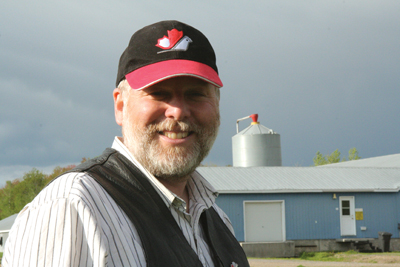
Truth Be Told
By André Dumont
Features Business & Policy Farm BusinessQuebec’s Martin Dufresne answers St-Hubert president’s criticisms
Last month’s issue of Canadian Poultry featured St-Hubert president Jean-Pierre Léger’s hard words on poultry production.
Last month’s issue of Canadian Poultry featured St-Hubert president Jean-Pierre Léger’s hard words on poultry production. Léger, who buys more than six million chickens annually, is concerned with overall quality, shortened bird lifetime, consumer perception of breeding methods and innovation in a supply-managed production. Most importantly, Léger wants to be the first one to offer antibiotic-free chicken in St-Hubert’s 100 restaurants.
 |
|
| Meeting the Challenge Quebec poultry farmers produce high-quality, tasty chicken, with nothing to hide from consumers, says Martin Dufresne, president of Les Éleveurs de volailles du Québec. And by 2010 they will be ready to provide without using antibiotics, to satisfy demand from St-Hubert BBQ chicken restaurants. Advertisement
|
In a follow-up interview, Martin Dufresne, president of Les Éleveurs de volailles du Québec, addressed these issues and made it public that Quebec chicken producers will be ready for antibiotic free production within two years.
“When a big player like St-Hubert wants something specific, we must answer,” Dufresne said. A provincial committee of leading producers, feed companies and meat processors is overseeing current progress in antibiotic-free production. Small-scale production does work, Dufresne says, but the challenge is to be successful lot after lot, on a large scale.
“We want to take the time it takes to achieve antibiotic-free production,” Dufresne said. “Because once we start, we wouldn’t want to have to interrupt deliveries if a problem occurs.”
Dufresne doesn’t believe antibiotic-free chicken will be healthier. Antibiotics are used very carefully and no traces are left when birds are processed, he says. “We will produce this chicken because there is demand, but as a producer, I’m not convinced that it will be better than regular chicken.”
Removing antibiotics from the feed will improve the public’s perception of chicken meat, Dufresne reckons. In addition, if producers are able to raise chicken successfully without antibiotics, most of them will not go back to using them, he said.
Dufresne contests the assertion – and perception – that antibiotics are used as growth factors. “A chicken that consumes antibiotics is in a better health; therefore its growth is easier.” In his view, antibiotics simply allow a bird to be at its best.
According to Dufresne, improved genetics and feed quality are what make it possible to finish chicken under 42 days. If the products that will be used to replace antibiotics are just as effective on bird health, bird lifetime will be the same, he says.
Unlike Léger, Dufresne doesn’t believe that finishing chicken in 35 days had an impact on quality. “The younger a chicken is, the more tender is the meat. That’s what St-Hubert clients appreciate. They don’t need to use a knife to eat their chicken.”
Such short lifetimes shouldn’t really bother consumers, Dufresne says. However, he says that although people are aware that growth times have been reduced, they are always surprised when they find out the actual number of days.
Producers have been shy to open their farms to the public, because of avian influenza, but according Dufresne, things are changing. Some farmers have installed glass panels that allow visitors to see that their birds are free to walk, eat and drink inside the henhouse.
Les Éleveurs de volaille du Québec have also launched an advertisement campaign, branding their product as “Well-raised Quebec chicken” (Poulet bien élevé du Québec), to show the public that farmers care about their birds’ well-being.
“The truth about how we treat our birds is very boring for journalists to investigate,” Dufresne said. “We have nothing to hide. We are much more afraid of myths – like that of growth hormones used in chicken – than of the reality.”
Answering Léger’s concern that supply management impedes innovation, Dufresne lists a number of specialty poultry products made in Quebec, like organic chicken, Chantecler heritage chicken, Cornouailles chicken and poultry of longer growth time and weight.
In poultry production, supply management doesn’t eliminate competition between farmers, Dufresne says. All are free to innovate, develop niche products and sell to whomever they want. Their poultry farmers’ organization can also be flexible. For example, Chantecler chicken producers were allowed to operate without quota and smaller farmers with seasonal productions are allowed to sell their entire production at any time of year.
Dufresne asserts that poultry production is open to everyone, despite high quota prices. “We are not a private club of producers.”
Access to poultry production requires a fair amount of capital, just like any other production, Dufresne says. The difference is that with supply management, a newcomer’s business plan can be based on stable revenues. This is a significant advantage when compared to buying land for grain production, Dufresne points out.
There are currently 850 chicken and turkey farmers in Quebec. That number is slightly higher than in the past years. Every year, four per cent of poultry quota is exchanged, with two per cent being transferred to family members.
Stable revenues doesn’t mean producers are laid back and don’t care about quality, Dufresne says. “Cost of production and quality go hand in hand. The best way to have a profitable farm is to have healthy birds.”
“We must be doing a good job, because chicken is the number one meat (32 kg per person) in Canada.”
Print this page